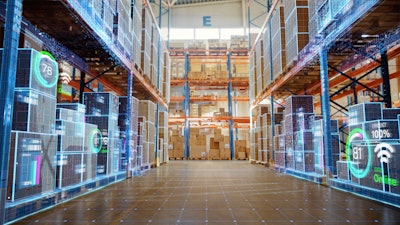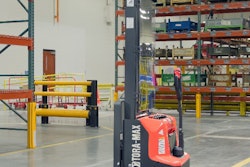
Sometimes just getting started can be the hardest step in the warehouse automation journey. Understandably, there is reason to hesitate, investigate and authenticate before purchasing and integrating new automation technology. Stories of false starts, overhyped benefits and unfulfilled expectations can make the decision even more intimidating.
Maybe you’re concerned that starting too early might render your chosen solution obsolete due to technology’s accelerated change of pace. Or you think there’s value in waiting, to learn by observing the actions of other companies. Maybe you’ve decided to wait until the technology is fully mature and your questions and concerns can be more readily addressed with off-the-shelf solutions.
No matter your reason for hesitation, now is a good time to consider starting your warehouse automation journey. Today’s modular, scalable and flexible automation solutions can be reconfigured and adapted to changing conditions and new processes to fit a variety of applications. The enabling hardware continues to become more advanced and affordable while ongoing software updates can provide new capabilities and functionality.
And while not every application can be automated due to process, facility or load quality considerations, beginning the journey allows you to take these things into consideration and determine where and how to start. Once you’ve decided to pursue automation, there are two essential changes you and your operations must undergo to help ensure a successful deployment: adopting an automation mindset and optimizing levels of standardization.
Adopting an Automation Mindset
Any significant technology investment and deployment should be adequately assessed and researched to determine the right fit and best approach. Beginning your automation journey or taking the next step in that journey, should be no different. Adopting automation is an investment and should be strategically planned and handled carefully to realize the desired return on that investment.
While cost and complexity can be valid concerns, beginning your automation journey can provide valuable benefits for your operations when done correctly and deliberately. Much of the technology involved is proven and available today.
Realizing tangible benefits requires first adopting the right frame of mind that looks beyond industry hype and unrealistic expectations and focuses on the genuine operational challenges you are trying to overcome and/or the tangible goals you want to accomplish.
There are many benefits that automation can provide when properly integrated into your operations. These may include:
- Improved workforce utilization
- Reduced operator fatigue
- Improved safety performance
- Increased productivity
- Enhanced accuracy
- More consistent throughput
- Heightened operational flexibility
Before moving forward with any automation deployment, you need to establish why you are doing it. What are you trying to overcome or accomplish? Which combination of the above benefits are you trying to realize? What is the order of priority?
You must also identify the tasks and equipment within your operations that are ideal candidates for automation. Not all of your warehouse tasks can be automated. It often depends on the available technology, the amount of customization and complexity involved and how easy it is to incorporate new workflows and processes to integrate the automation.
Some of the warehouse tasks that have shown to be ideal candidates for automation include load transportation throughout the warehouse, pallet putaway and retrieval and order picking, transportation of finished goods from manufacturing to warehouse and delivery or replenishment of WIP materials throughout the assembly process.
It helps to understand how your forklifts are being used and how and when pallets are moving in your facility. Where can warehouse employees be relieved of lesser-value tasks so they can focus on more strategic and value-adding tasks that enhance operational performance?
Telematic systems, especially when connected to other warehouse systems, can play a vital role in implementing forklift automation, identifying potential use cases, informing your automation strategy, measuring performance and helping you ensure success.
Depending on your system’s setup and the measurement metrics you are using, you can gather a wealth of data about your operations and how your pallets are moving throughout your facility.
As you add more automated and semiautomated vehicles to your fleet, the added connectivity and data gathered can help you manage the process and determine if objectives are being met. Automated solutions are effective and contribute a return on your investment only when they are in operation, so it is equally important to understand when they are idle.
Optimizing Levels of Standardization
There are two ways to think about standardization when considering automation technologies to purchase and implement. First, there is the level of standardization that comes from implementing best practices learned either through your own experience or that of others who have implemented automated solutions.
While each application and environment can differ, this type of standardization gives you a starting point to plan and deploy the technology. By working closely with your technology provider, you benefit from their knowledge of the technology and their experience with deploying it while working with various companies on similar installations. This combination of knowledge and experience provides a solid foundation on which to build and then customize your approach to overcome challenges and meet your unique requirements.
As you begin to consider your operation, it is time to introduce the second form of standardization, vital to many automated vehicle deployments: standardizing internal processes and requirements. Regardless of the technology and application, you will most likely need to make some changes to your operations.
For instance, if you seek to deploy an automated forklift for pallet putaway and retrieval, you’ll need to standardize the handling and condition of your pallet loads. Palletized materials that are not properly stacked and shrink-wrapped can impede the function of the automated forklift, resulting in exceptions that bring your system to a stop. Uniformity and quality assurance in your pallet loads will help facilitate consistent operation and improve efficiency and productivity.
The more you can standardize your processes and control pallet load quality, the better the interaction of your automated forklifts with your environment. While the immediate benefit is to automate the task, identifying and implementing such improvements can positively affect your entire operation. In many cases, these opportunities for improvement, like improper shrink wrapping or skewed pallet loads, existed before introducing the automated technology. The installation simply serves as the catalyst to address them with needed adjustments.
Setting Realistic Expectations
Remember, any effort to introduce automation into your facility should be guided by a realistic plan with achievable expectations that can also be scalable based on success and growth. You should develop a clear path for a tangible return on investment and determine a process and mechanism for building upon your success. This will help you strategically grow and evolve your automation efforts as you continue your journey.
Many of the challenges you currently face, including hiring challenges, supply chain disruptions and changing consumer demands, can be either resolved – or significantly diminished – with today’s automation technology. Adopting an automation mindset and optimizing levels of standardization, along with working with a trusted technology partner, can help ensure the technology is successfully integrated and aligned with your business objectives.



![Pros To Know 2026 [color]](https://img.sdcexec.com/mindful/acbm/workspaces/default/uploads/2025/08/prostoknow-2026-color.mduFvhpgMk.png?auto=format%2Ccompress&bg=fff&fill-color=fff&fit=fill&h=100&q=70&w=100)







![Pros To Know 2026 [color]](https://img.sdcexec.com/mindful/acbm/workspaces/default/uploads/2025/08/prostoknow-2026-color.mduFvhpgMk.png?ar=16%3A9&auto=format%2Ccompress&bg=fff&fill-color=fff&fit=fill&h=135&q=70&w=240)







